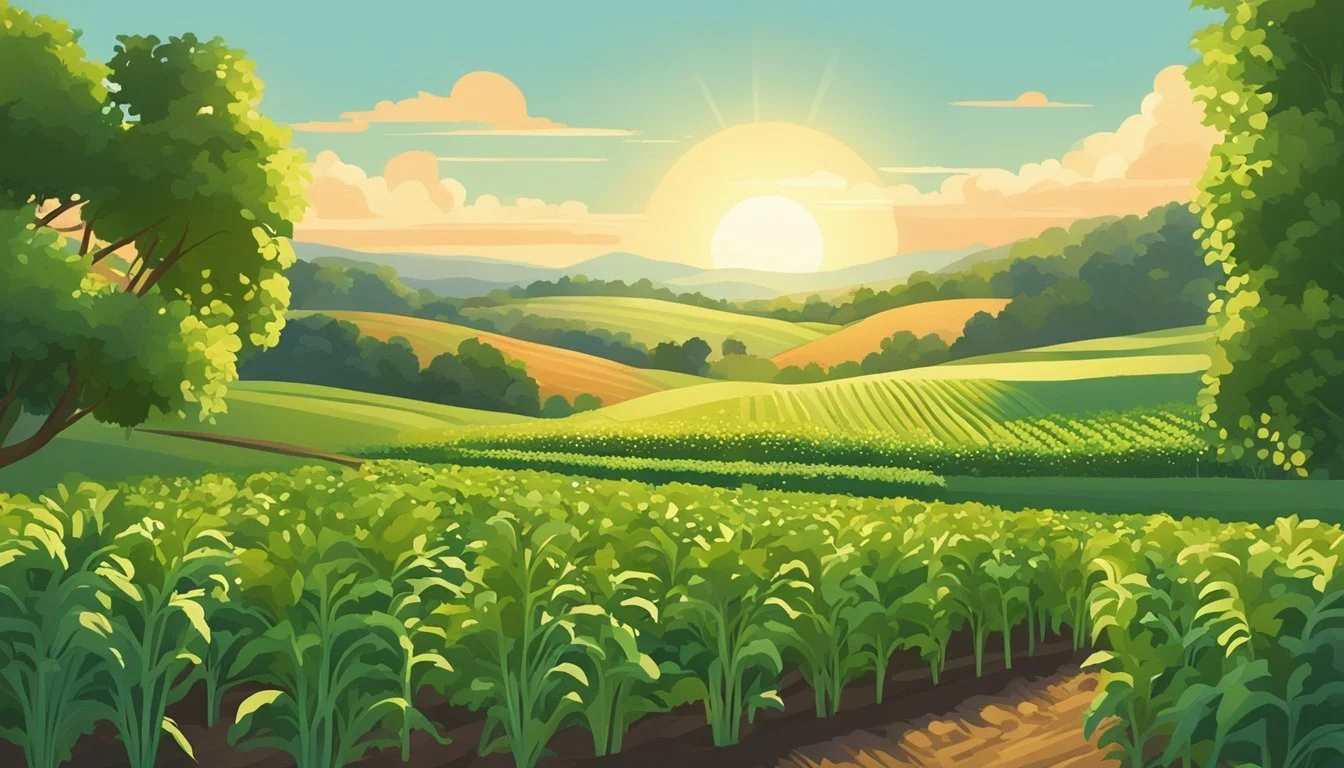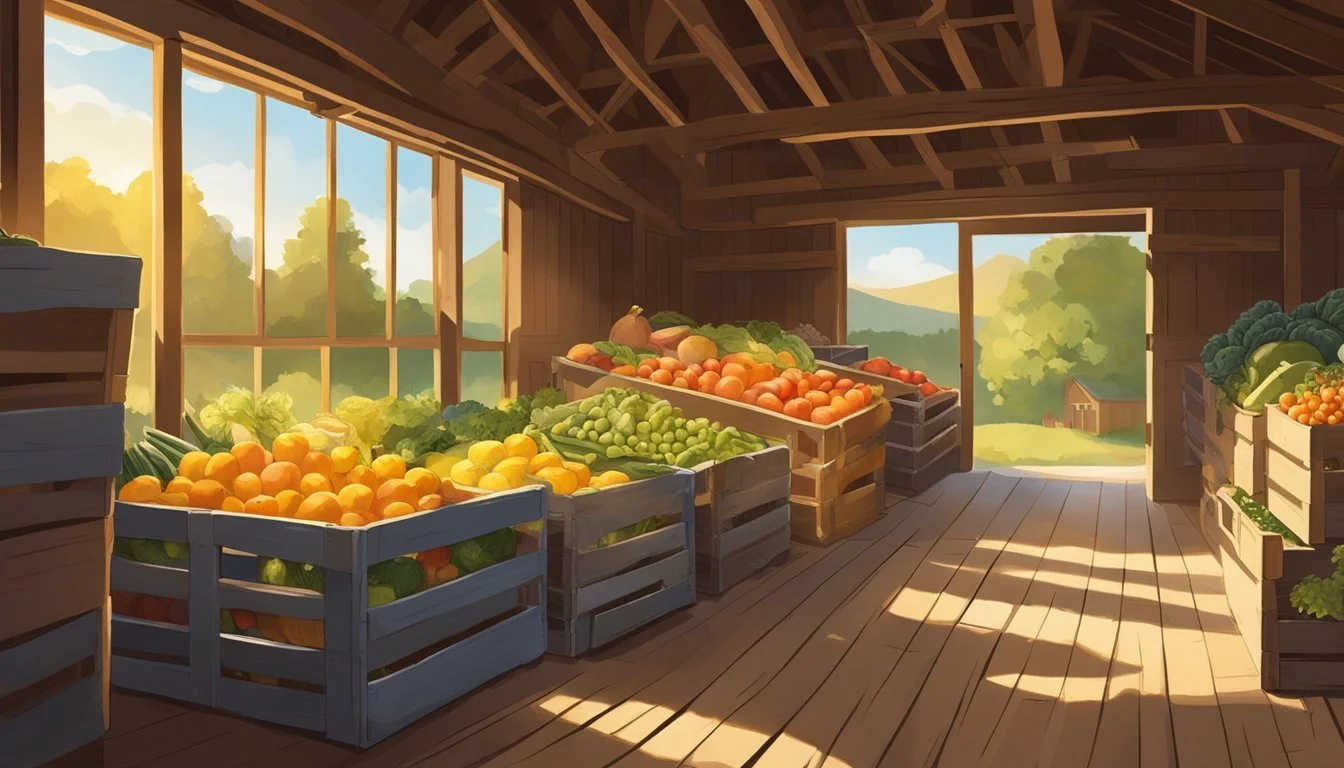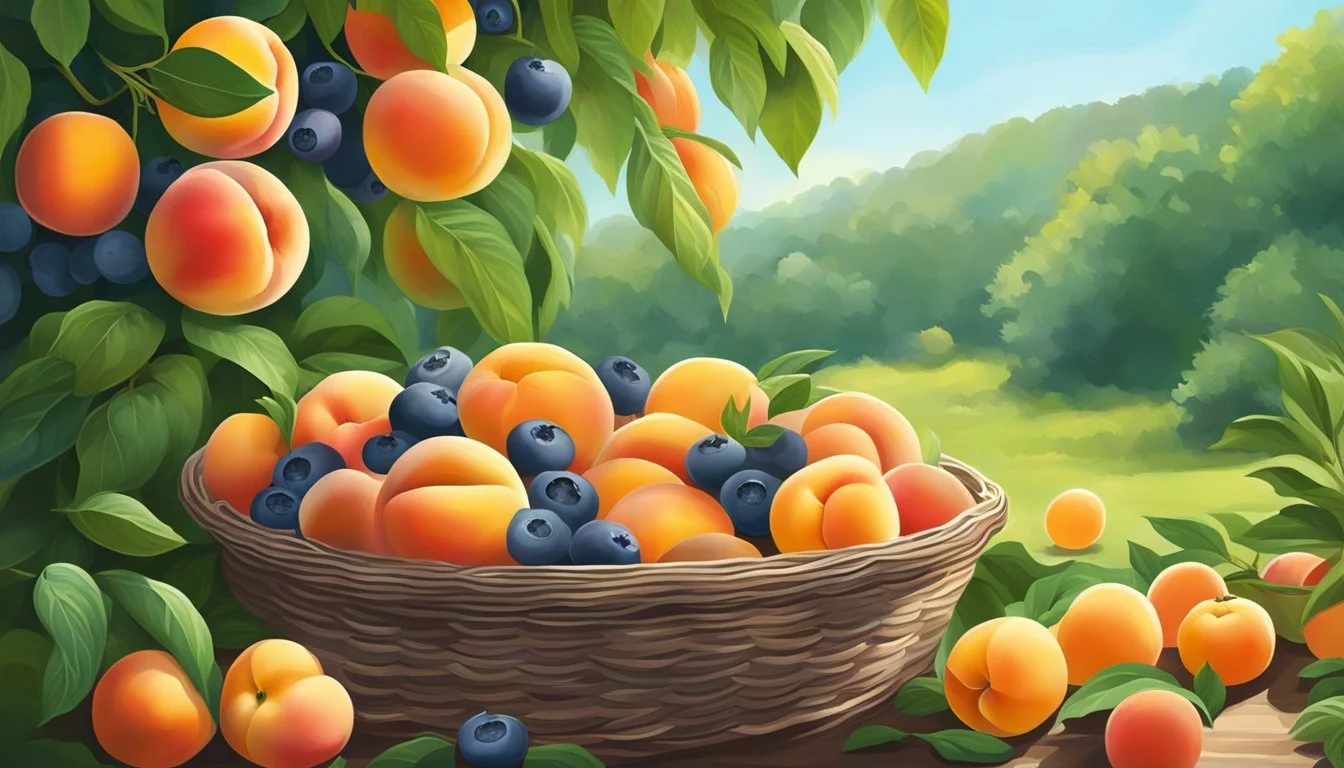Vermont Seasonal Fruit & Vegetables in August
Your Guide to Fresh Produce Selection
This Article is Part of our Vermont Seasonal Fruit & Veg Calendar
August in Vermont showcases the abundant harvest of both fruit (What wine goes well with fruit?) and vegetables at their peak of freshness. As local farmers and gardeners reap the rewards of the growing season, a rich variety of produce becomes available, providing a tapestry of flavors and nutritional value. The array of products includes, but is not limited to, beans, beets, broccoli, carrots, cauliflower, fennel (how long does fennel last?), greens, kale, lettuce, melons, peas, potatoes, radishes, raspberries, and spinach. These items, found at local markets, not only offer peak flavor but are also at their most cost-effective during this period.
The importance of eating seasonally is underscored in Vermont, where the climate and soil contribute uniquely to the growth cycles of regional produce. August's bounty is particularly significant as it represents the culmination of both summer's warmth and the preparatory work undertaken in spring. It's the ideal time for consumers to engage with their local food economy and savor the fruits and vegetables that are especially available during this month.
Vermont's seasonal produce calendar serves as a guide for those looking to incorporate fresh, locally sourced ingredients into their diets. The state's agricultural offerings deliver a promise of quality and sustainability, encouraging a connection between Vermont residents and the land that feeds them. This relationship fortifies community ties and supports a healthier lifestyle grounded in the rhythms of nature.
Overview of Vermont's Growing Season
In Vermont, the agricultural season is carefully attuned to the state's distinct climate patterns and geography, which significantly influences the growth and harvest times of various crops, particularly in the height of summer in August.
Typical Climate and Seasonal Shifts
Vermont experiences a diverse range of weather conditions throughout the year, with each season distinctly impacting agricultural practices. The summer months, especially July and August, are characterized by warm temperatures that typically range from 57°F to 81°F. This period sees longer days and increased sunlight, providing optimal conditions for many crops to flourish. However, the growing season in Vermont is shorter relative to many other states due to its northern location, which makes the timing of planting and harvesting particularly important to maximize yield and quality.
August in Vermont's Agricultural Calendar
By August, Vermont's agriculture is in the late summer phase, which means that many crops planted in the spring and early summer are ready for harvest. Seasonal shifts from July to August play a vital role in determining the peak times for harvesting a variety of fruits and vegetables. During this month, crops such as tomatoes (What wine goes well with tomatoes?), peppers, cucumbers (how long do cucumbers last?), squashes, and berries are typically at their peak, having benefitted from the warm summer temperatures. Farmers and gardeners in Vermont make the most of the late summer's conducive growth conditions before the onset of cooler temperatures in the fall.
Impact of Soil and Topography
The soil and topography of Vermont also play crucial roles in the state's growing season. Vermont's soil is generally rich and fertile, composed of a variety of soil types ranging from loamy to clayey, accommodating a wide array of produce. The topography, with its rolling hills and valleys, can create microclimates that affect when and what can be planted. For instance, low-lying areas may be prone to late frosts, which can delay planting times. On the other hand, well-drained, higher elevation areas may have slightly longer growing seasons, allowing for a broader variety of crops to be cultivated successfully.
Fruits in Season
In August, Vermont's fruitful bounty is at one of its peaks, providing a plethora of options ranging from succulent stone fruits and berries to refreshingly sweet melons. Consumers can relish the freshness and indulge in the state's seasonal produce.
Stone Fruits and Berries
Stone Fruits: The warmth of August ripens a variety of stone fruits to perfection. One can expect:
Peaches: Juicy and aromatic, perfect for pies or enjoyed fresh.
Plums: With a sweet and tart flavor, suited for jams or eating out of hand.
Nectarines: Similar to peaches, but with smooth skin and can be used interchangeably in recipes.
Cherries (how long do cherries last?): Sweet or tart varieties available, ideal for snacking or desserts.
Berries, a hallmark of summer, are also in full swing:
Blueberries: Bursting with flavor, these berries are great for baking or as a healthy snack.
Blackberries: Larger than their berry counterparts, they are perfect in cobblers or eaten alone.
Raspberries: Fragile and sweet, suited for sauces, jams, or fresh consumption.
Melons and Tropical Varieties
Melons: These juicy fruits are at their peak, offering a cool respite on a hot August day:
Watermelon: A quintessential summer fruit, refreshing and hydrating.
Cantaloup: Also known as muskmelon, with a sweet and soft flesh.
Honeydew: Subtly sweet with a pale green flesh that's often enjoyed in fruit salads.
While Vermont is not typically associated with tropical fruits, some offerings may be available due to modern agricultural practices:
Mangos: They might be sourced regionally where conditions permit or from nearby locales; versatile in dishes, they offer a tropical twist.
Tomatillos: While technically a fruit, they are commonly used in savory dishes and are a staple in green salsas.
It's important to remember Tomatoes, often mistaken for vegetables, are a fruit and an important part of the culinary landscape in August, with heirloom and vine-ripened varieties in abundance.
Vegetables Harvest in August
As August arrives in Vermont, gardens and farms become bountiful with a variety of vegetables ready to be harvested. This time of year is especially rich in root vegetables and tubular crops, leafy greens along with fragrant herbs, and a selection of nightshades and squashes, each offering fresh flavors and nutrition.
Root Vegetables and Tubers
Root vegetables reach their peak in August, delivering both flavor and nutrients. They include:
Carrots: Sweet and crunchy, they're perfect for raw snacks or cooked dishes.
Beets: Earthy and deep red, beets can be roasted, boiled, or eaten raw.
Potatoes: A versatile staple that can be cooked in countless ways.
Radishes: Crisp and peppery, ideal for a fresh salad bite.
Leafy Greens and Herbs
Leafy greens and herbs thrive in the late summer weather of Vermont. Here are some to look for:
Kale: A hearty green that is a superfood, known for its health benefits.
Chard: With a beet-like flavor and spinach texture, it is great in sautés.
Arugula: This peppery green elevates salads and sandwiches.
Herbs: Fresh herbs such as basil (how long does basil last?), thyme, and cilantro complement a myriad of dishes.
Nightshades and Squashes
August marks a peak season for both nightshades and squashes in Vermont, including:
Tomatoes: Juicy and ripe, from cherry tomatoes to Heirlooms, they are a summer icon.
Peppers: Ranging from sweet to hot, peppers add flavor to any dish.
Eggplant (What wine goes well with eggplant?): With a spongy texture, they are excellent for dishes like ratatouille (What wine goes well with ratatouille?).
Summer Squash and Zucchini: Tender and mild, they are versatile for grilling, sautéing, or baking.
Green Beans: Crisp and tender, perfect for salads, side dishes, or casseroles.
Harvesting and Storing Tips
This section is dedicated to ensuring that the reader understands the nuances of collecting and preserving Vermont's seasonal produce in August.
Proper Harvesting Methods
Summer in Vermont is a bounty for fresh produce; August harvest requires precision to ensure optimal freshness and flavor. Beans should be picked while firm and snap easily, and tomatoes are best harvested when they have a uniform color and slight give upon touch. For cucumbers, ideal harvest time is when they're bright green and firm. Corn ears should feel plump through the husk, and silks should be brown and dry at the ends.
Storage and Preservation
Once harvested, the way fruits and vegetables are stored can drastically affect their longevity and taste. Freezing is a viable option for many items; cut beans into bite-sized pieces, blanch, and freeze to maintain their crispness. Tomatoes can be transformed into spaghetti sauce or salsa and canned for later use. Cucumbers convert well into pickles through canning as well. Eggplants (What wine goes well with eggplant?) are great for making baba ganoush, which can be refrigerated for short-term use. Fruits like berries can be cleaned, dried, and frozen on a tray before transferring to a freezer bag, or made into jam for canning.
Recipes and Preparation Ideas
August in Vermont ushers in an abundance of fresh produce that offers endless possibilities for culinary exploration. From crisp salads to sweet preserves, the local harvest provides the perfect ingredients for a variety of dishes.
Simple and Fresh Dishes
One can revel in the simplicity of Vermont's August bounty with dishes that let the produce shine. A classic caprese salad of ripe tomatoes, fresh basil, and mozzarella is elevated with a drizzle of balsamic glaze. Pairing stone fruit such as peaches with mixed greens, a sprinkle of Parmesan, and a light vinaigrette creates a refreshing salad perfect for warm summer days.
Cucumber Salad:
Thinly sliced cucumbers
Diced mango
A hint of red pepper flakes (how long do red pepper flakes last?)
A splash of rice vinegar
Preserves and Canned Goods
Preserving the August harvest allows one to savor the flavors well into the colder months. Stone fruits like peaches and plums can be transformed into jams and jellies, capturing the sweetness of summer. For something more savory, pickling a mix of bell peppers and cucumbers in a vinegar brine with spices can add a tangy crunch to meals.
Preserve Type Ingredients Suggested Jam Figs, Sugar, Lemon Juice Pickles Cucumbers, Dill, Garlic
Creative Cuisine Inspirations
Adventurous cooks might explore more sophisticated dishes that incorporate August's seasonal produce in Vermont. A rustic tomato sauce made from heirloom tomatoes can serve as a base for many dishes from pasta to seafood. Roasted pumpkins might be pureed into a smooth soup, enhanced with a touch of cream and garnished with crispy fried basil leaves. A daring chef might also consider creating a sweet-and-spicy mango chutney (how long does mango chutney last?) to accompany grilled meats or as a unique sandwich spread.
Roasted Pepper Dip:
Charred Vermont peppers
Pureed with garlic and almonds
Seasoned with smoked paprika (how long does smoked paprika last?)
Understanding Crop Availability
In Vermont, August marks a peak in the diversity of fresh produce as many fruits and vegetables reach prime ripeness. Accurate charts and an understanding of regional agricultural patterns guide consumers to the best of the season's offerings.
Seasonal Availability Charts
Fruits in August: They include a variety of apples, blackberries, and blueberries. Charts indicate that these fruits are typically at their peak.
Vegetables in August: The charts reveal an abundant availability of beans, beets, broccoli, cabbage, carrots, cauliflower, celery, chard, corn, cucumbers, eggplant, fennel, garlic, greens, kale, leeks, and lettuce.
For transition months like June, July, September:
June: Early summer crops begin to appear.
July: Many of the crops available in August start to come into season.
September: Some of the summer produce starts to wane as fall varieties emerge.
Factors Influencing Crop Yields
Weather: It plays a crucial role in the success of crop yields. Anomalies such as a late frost in June or excessive rainfall can delay or damage crops.
Soil Conditions: The quality of Vermont's soil, which varies from farm to farm, can affect the timing and quality of the harvest.
By understanding these factors, consumers can better anticipate the availability of fresh, local produce during the summer season in Vermont.
Supporting Vermont's Local Agriculture
August in Vermont showcases a bounty of fresh fruits and vegetables, making it a pivotal time for supporting local agriculture. The state's robust local foods incentive programs reflect an ongoing commitment to sustaining and promoting Vermont's family farms and small producers.
Community engagement is at the heart of Vermont's agricultural model, with initiatives such as the "Farm to Family Coupon" program enhancing access to local produce. These efforts are critical, as they directly connect consumers with farmers markets and farm stands, reinforcing the cycle of local spending and boosting the garden state's economy.
Local food economies not only thrive on direct consumer sales but also benefit from partnerships with schools and institutions. Programs aimed at integrating Vermont-grown foods into these venues foster an appreciation for local fare from an early age, encouraging lifelong support for community farming.
Emphasizing organic and sustainable practices, Vermont farms contribute to the health of both residents and the environment. The state puts great value on maintaining a transparent relationship between consumers and their food sources, with traceability playing a key role in the food system.
Vermont continually adapts to challenges like climate change and shifting market demands, ensuring the viability of local agriculture. The state's strategic approach involves a collaborative effort, leveraging expertise from all sectors to support a vibrant, adaptable, and equitable food landscape.








